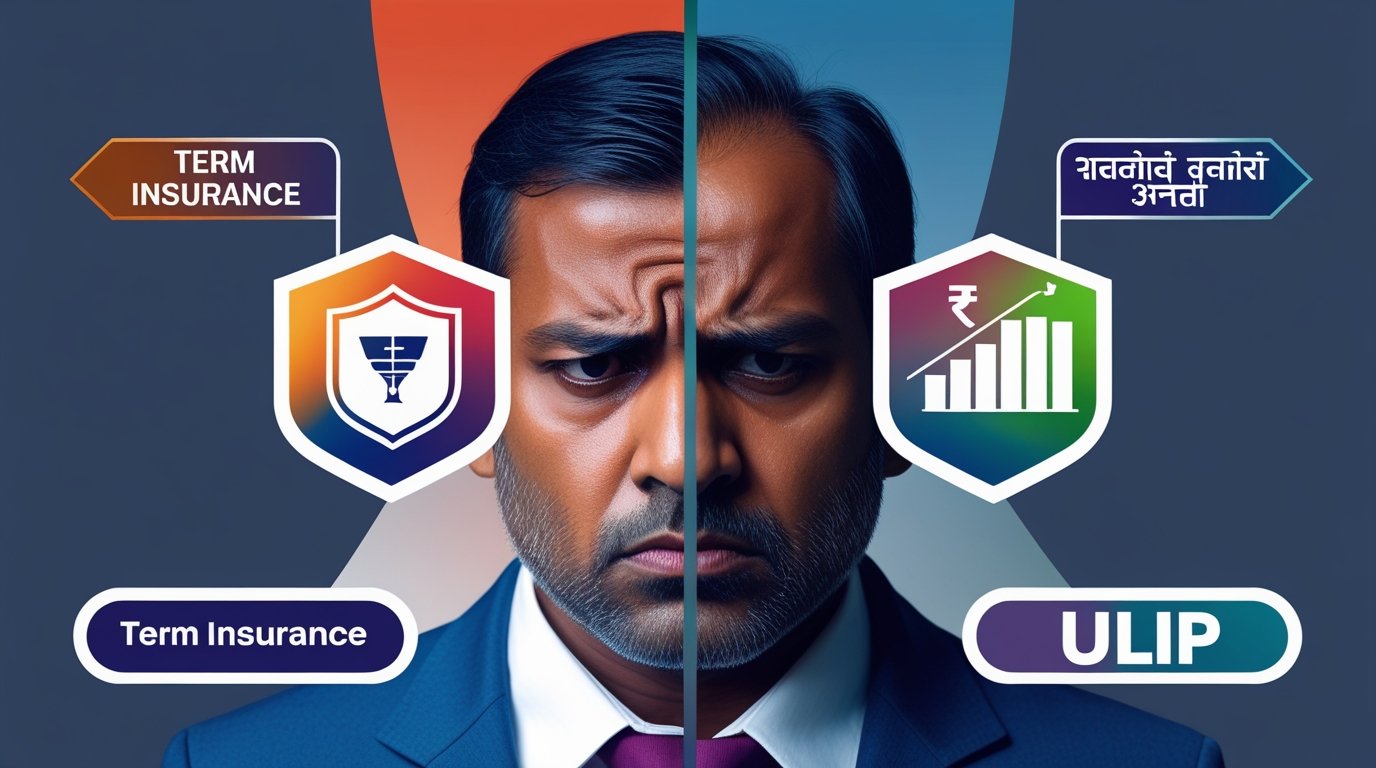Choosing the right financial product to secure your future can feel overwhelming. Should you opt for term insurance, which offers straightforward life coverage, or a Unit Linked Insurance Plan (ULIP), blending insurance with investment? Both have unique benefits, but picking the wrong one could cost you peace of mind or financial growth. This article breaks down term insurance vs ULIP, helping you make an informed decision based on your goals, risk appetite, and budget. By the end, you’ll understand their differences, benefits, and which option suits your needs in 2025.
What Is Term Insurance?
Term insurance is a pure life insurance product designed to provide financial protection for your loved ones in case of your untimely death. It offers a high sum assured at a low premium, making it an affordable choice for many.
Key Features of Term Insurance
- Pure Protection: Pays a death benefit if the policyholder passes away during the policy term.
- Affordable Premiums: Low-cost compared to other insurance products.
- No Investment Component: Focuses solely on life cover, not wealth creation.
- Flexible Terms: Choose policy terms (e.g., 10, 20, or 30 years) based on your needs.
- Tax Benefits: Premiums and payouts are eligible for tax deductions under Section 80C and 10(10D) of the Income Tax Act, 1961.
Who Should Choose Term Insurance?
Term insurance is ideal for:
- Young professionals or breadwinners seeking high coverage at low costs.
- Individuals with dependents who prioritize financial security.
- Those with limited budgets who want pure life protection without investment goals.
Example: Raj, a 30-year-old software engineer, earns ₹10 lakh annually and has a wife and young child. He buys a ₹1 crore term insurance policy for ₹12,000/year to ensure his family’s financial stability if something happens to him.
What Is a ULIP?
A Unit Linked Insurance Plan (ULIP) combines life insurance with market-linked investments. Part of your premium goes toward life cover, while the rest is invested in funds (equity, debt, or hybrid) chosen by you.
Key Features of ULIPs
- Dual Benefit: Offers life cover plus wealth creation through investments.
- Flexibility: Switch between funds (e.g., equity to debt) based on market conditions or goals.
- Lock-in Period: Typically 5 years, encouraging long-term investment.
- Tax Benefits: Similar to term insurance, premiums qualify for tax deductions under Section 80C, and maturity proceeds are tax-free under Section 10(10D).
- Higher Costs: Premiums are higher due to the investment component and associated charges (fund management, mortality, etc.).
Who Should Choose ULIPs?
ULIPs suit:
- Investors comfortable with market risks and seeking wealth creation alongside insurance.
- Individuals with long-term financial goals, like funding education or retirement.
- Those with surplus income to allocate toward investments.
Example: Priya, a 35-year-old entrepreneur, invests ₹50,000 annually in a ULIP. She allocates 60% to equity funds and 40% to debt funds, aiming to build a corpus for her daughter’s education while securing life cover.
Term Insurance vs ULIP: A Detailed Comparison
To help you decide, here’s a side-by-side comparison of term insurance and ULIPs based on key factors:
| Criteria | Term Insurance | ULIP |
|---|---|---|
| PurposeගPurpose** | Life coverage only | Life coverage + investment |
| Cost | Low premiums | Higher premiums due to investment component |
| Returns | No returns, only death benefit | Potential for returns based on fund performance |
| Risk Level | Low (fixed payout) | Medium to high (market-linked) |
| Lock-in Period | None | 5 years |
| Flexibility | Fixed plan | Fund switching allowed |
| Tax Benefits | Premiums and payouts tax-exempt | Premiums and maturity proceeds tax-exempt |
Pros and Cons of Term Insurance
Pros:
- Affordable and simple.
- High coverage for low premiums.
- Ideal for pure financial protection.
Cons:
- No maturity benefits.
- No wealth-building component.
Pros and Cons of ULIPs
Pros:
- Combines insurance and investment.
- Potential for higher returns.
- Flexible fund options.
Cons:
- Higher costs and charges.
- Market-related risks.
- Longer commitment (lock-in period).
Which One Should You Choose in 2025?
Your choice depends on your financial goals, risk tolerance, and budget. Here’s a quick guide:
- Choose Term Insurance If:
- You want affordable, high-value life cover.
- Your primary goal is to protect your family’s financial future.
- You prefer low-risk financial planning or have limited funds.
- Choose ULIP If:
- You’re comfortable with market risks and want to grow wealth.
- You have long-term financial goals (e.g., 10+ years).
- You can afford higher premiums and want flexibility in investments.
Case Study: Anil, a 40-year-old father of two, wants to secure his family and save for retirement. He opts for a ₹50 lakh term plan for immediate protection and invests separately in mutual funds for wealth creation, balancing cost and growth.
What’s New in 2025?
In 2025, both term insurance and ULIPs have evolved:
- Term Insurance: New plans offer add-ons like critical illness or accidental death riders, enhancing coverage. Online platforms make purchasing easier with transparent pricing.
- ULIPs: Enhanced transparency in charges and improved fund performance tracking are making ULIPs more appealing. Some plans now offer lower-cost structures to compete with mutual funds.
Tip: Check for IRDAI-regulated insurers to ensure trustworthiness. Websites like Policybazaar or IRDAI provide reliable comparisons.
FAQ Section
What is the main difference between term insurance and ULIP?
Term insurance provides pure life coverage with no investment component, offering high sums assured at low premiums. ULIPs combine life insurance with market-linked investments, aiming for wealth creation but with higher costs and risks.
Which is better for young professionals?
Young professionals with limited budgets often prefer term insurance for its affordability and high coverage. Those with surplus income and a risk appetite may opt for ULIPs to build wealth over time.
Are ULIPs riskier than term insurance?
Yes, ULIPs carry market-related risks, as returns depend on fund performance. Term insurance has no investment risk, providing a fixed death benefit.
Can I get tax benefits from both?
Both term insurance and ULIPs offer tax deductions on premiums under Section 80C and tax-free payouts under Section 10(10D) of the Income Tax Act, 1961, subject to conditions.
How do I choose the right sum assured?
Calculate your annual income, debts, and future expenses (e.g., education, marriage). A common rule is 10-15 times your annual income for term insurance. For ULIPs, factor in your investment goals and risk tolerance.
What are the charges associated with ULIPs?
ULIPs include premium allocation, policy administration, fund management, and mortality charges. These can reduce returns, so review the cost structure before investing.
Conclusion
Choosing between term insurance and ULIP boils down to your financial priorities. If you seek affordable, high-value life coverage, term insurance is the way to go. If you’re aiming for wealth creation alongside insurance and can handle market risks, ULIPs might be better. Evaluate your budget, goals, and risk tolerance before deciding. For personalized advice, consult a financial advisor or visit trusted platforms like Policybazaar. Share your thoughts or questions in the comments below, or sign up for our newsletter for more financial tips!
Suggested Visuals:
- A comparison infographic of term insurance vs ULIP.
- A video explaining how ULIPs work (link to a trusted source like Moneycontrol).


1 thought on “Term Insurance vs ULIP: Which One Should You Choose?”